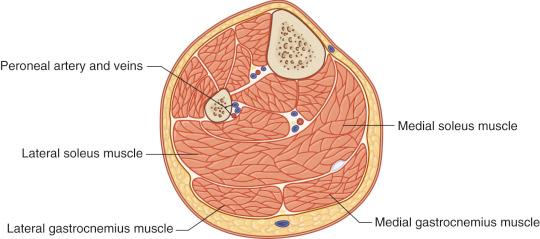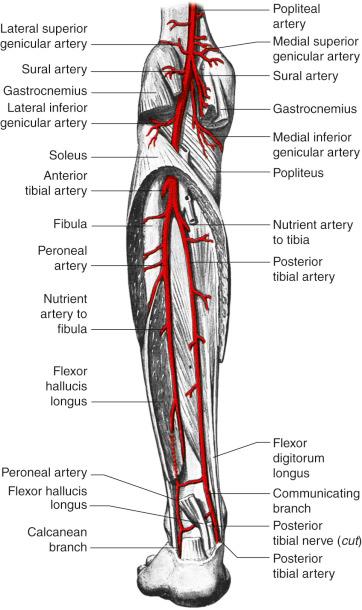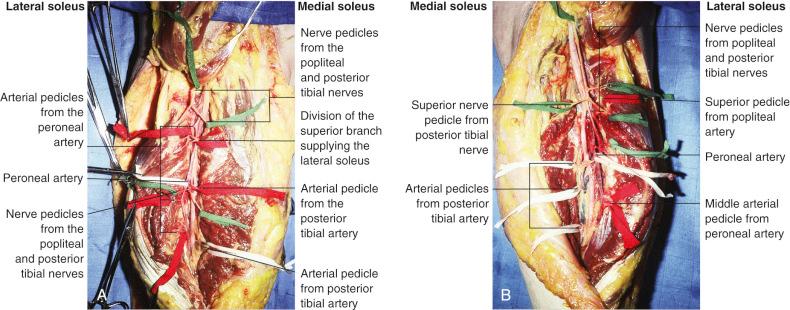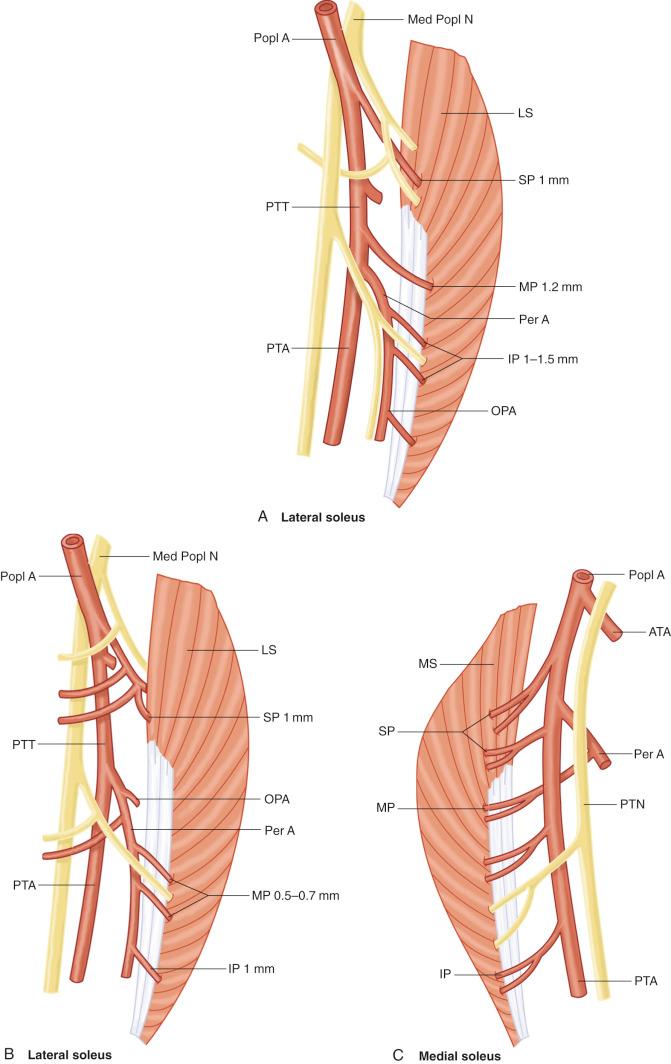Physical Address
304 North Cardinal St.
Dorchester Center, MA 02124
The soleus muscle, one of the components of the superficial posterior compartment of the leg, was used initially as a local flap, as described by Ger and later, by Mathes and Nahai. Since then, multiple surgical modalities have been described that have approached this flap in different ways and used it for different purposes, as both a local and a free flap. Its use requires precise anatomic knowledge to gain the utmost benefit from its versatility. It deserves to be more extensively used due to its wide coverage potential and minimal negative effects at the donor site. The soleus muscle is often harvested as part of the fibula flap (see Ch. 52 ).
The soleus muscle is a large, broad, and rather long muscle located at the posterior aspect of the leg. It is a bipenniform muscle consisting of a lateral and a medial head. The lateral head originates from the fibula head and body and the medial head originates from the medial side of the middle third of the tibia. The lateral and medial soleus muscles are separated in the midline by a septum, which is present in the distal part of the muscle. The two muscle heads join together to form the dorsolateral and dorsomedial component of the Achilles tendon. This tendon, which is formed by the soleus and gastrocnemius muscles, inserts on the calcaneum tuberosity ( Fig. 51.5 ).
The anatomic findings presented in this chapter are based on a study by Caix, in an article by Baudet and colleagues published in 1982. This study was performed on 22 fresh cadavers.
We will use the following terms to describe the soleus muscle in this chapter:
Soleus muscle (implying the entire muscle)
Medial head of the soleus muscle
Lateral head of the soleus muscle.
The vasculo-nervous (neurovascular) pedicles to the lateral soleus muscle are usually found at three levels, providing what we term the “upper, middle, and inferior pedicles” of the lateral soleus muscle. These three pedicles are mainly derived from collateral branches of the peroneal vessels and, in some cases, the inferior pedicle is derived from the posterior tibial artery. The middle pedicle provides the main blood supply to the muscle and is made up of two (76%); or three (24%) branches.



branch from the popliteal artery (“upper pedicle”)
Length: 2.3 cm (range 1.2–5 cm)
Diameter: 1.3 mm (range 0.5–2 mm)
This branch is part of what is considered the “upper pedicle”; it is constant and is accompanied by venae comitantes. It penetrates the muscle 2.2 cm below the fibula head. One nerve branch emerging from the medial popliteal nerve joins this arterial branch.
branch from the tibioperoneal artery or peroneal artery (upper branch of the “middle pedicle”)
Length: 1.4 cm (range 0.5–3.5 cm)
Diameter: 1.9 mm (range 1–3 mm)
This branch is part of what is considered the “upper branch” of the “middle pedicle.” In 45% of cases, this branch comes from the peroneotibial artery and in 55% of cases, from the peroneal artery. The distance of origin of this branch from the anterior tibial artery is 3.3 cm. The point of penetration into the muscle is 7.5 cm from the head of the fibula.
branch from the peroneal artery (lower branch of the “middle pedicle”)
Length: 1.6 cm (range 0.3–4.0 cm)
Diameter: 1.73 mm (range 0.5–3.5 cm)
This is termed the “lower branch” of the “middle pedicle.” It is always derived from the peroneal artery. The distance of origin of this branch from the anterior tibial artery is 5.68 cm and the point of penetration into the muscle is 9.9 cm from the head of the fibula. This lower branch is absent in 9% of the population (two out of 22 in our study). In 13.6% of cases (three out of 22 in our study) a third branch of the middle pedicle was present.
branch from the peroneal artery (50%) or from the posterior tibial artery (50%) (“inferior pedicle”)
Length: 2.4 cm (range 1.2–3.5 cm)
Diameter: 1.1 mm (range 0.5–2 mm)
This branch is considered part of the “inferior pedicle” of the flap and is an accessory pedicle. In half of the cases it originates from the peroneal artery and in the other half from the posterior tibial artery. The distance of origin from the anterior tibial artery is 11.5 cm and the point of penetration into the muscle is 10.7 cm. The inferior pedicle is absent in 18% of cases.
The medial soleus is supplied by several pedicles emerging from the peroneotibial and posterior tibial vessels ( Fig. 51.6C ).
upper pedicle, division of the upper branch supplying the lateral soleus
middle pedicle, most often three branches emerging from the posterior tibial artery
inferior pedicle common with the lateral soleus supply
perforating vessels from both gastrocnemius muscles emerging from the perifibular peroneal artery arcade
intramuscular cross-anastomoses between the lateral and medial soleus
These branches were elucidated from our anatomic study and they are very important in clinical application since the whole soleus can be harvested on a single branch from the peroneal pedicle and used as a regional or even free flap transfer. Two clinical cases will be presented in further detail, below.
venae comitantes running along the arterial branches
The venae comitantes all drain into the peroneal, postero-tibial and finally, the popliteal veins. There are some cross-anastomoses with the superficial subcutaneous vein. Each main pedicle and collateral branches have two venae comitantes, their diameter being larger than that of the adjacent artery. They drain finally into the popliteal vein but there are some cross-anastomoses with the superficial subcutaneous vein. Including a skin paddle with the muscle flap can help to solve the venous drainage by anastomosing one or several veins (main trunk or collateral branches from the long saphenous vein or short saphenous vein).
According to Taylor's classification, the soleus should be classified as a type 3 muscle in terms of nerve supply: multiple motor nerve branches derived from the same nerve trunk.


branches from the medial popliteal and tibial nerves:
An upper branch which originates from the medial popliteal nerve, ranging from 0.5 mm to 2 mm
Two middle branches emerging from the tibial nerve
An inferior branch which is not constant.
Three branches from the posterior tibial nerve; usually there are three nerve branches.
If a skin paddle is included in the flap and a sensory branch supplying the skin (e.g., branches of the sural nerve) can be included and anastomosed with the recipient site ( Figure 13.19 ).
The soleus flap is harvested as a muscle flap. It can include fascia overlying the muscle, tendons such as part of the Achilles tendon, bone by including the fibula based on branches from the peroneal artery which supply the fibula and lateral soleus muscle, and skin by including the lateral skin overlying the fibula.
If necessary, a skin paddle can be harvested with the medial head of soleus. It is supplied by musculocutaneous perforators.
Become a Clinical Tree membership for Full access and enjoy Unlimited articles
If you are a member. Log in here